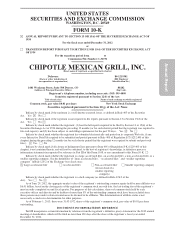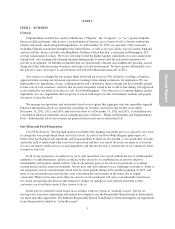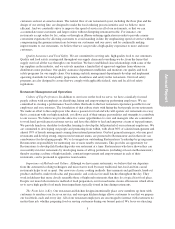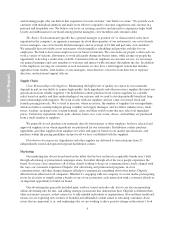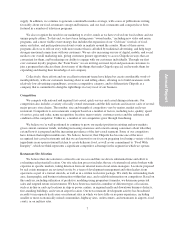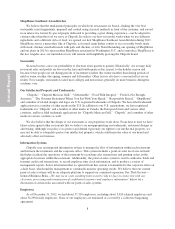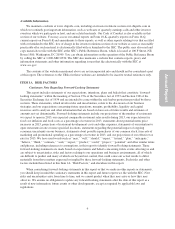Chipotle 2012 Annual Report Download - page 6
Download and view the complete annual report
Please find page 6 of the 2012 Chipotle annual report below. You can navigate through the pages in the report by either clicking on the pages listed below, or by using the keyword search tool below to find specific information within the annual report.
We’re also investigating the use of more sustainably grown produce, meaning produce grown by suppliers
who we believe respect the environment and their employees. A portion of some of the produce items we serve is
organically grown, or sourced locally while in season (by which we mean grown within 350 miles of the
restaurant). A portion of our beans is organically grown and a portion is sustainably grown using conservation
tillage methods that improve soil conditions, reduce erosion, and help preserve the environment in which the
beans are grown. Our commitment to Food With Integrity extends to the dairy products we serve as well. The
sour cream and cheese we buy is made with milk that comes from cows that are not given rBGH (recombinant
bovine growth hormone). Also, milk used to make much of our cheese and some of our sour cream is sourced
from dairies that provide an even higher standard of animal welfare by providing outdoor access for their cows.
We do, however, face challenges associated with pursuing Food With Integrity. There are higher costs and
other risks associated with purchasing ingredients grown or raised with an emphasis on quality, sustainability and
other responsible practices. Growth rate and weight gain can be lower for chickens, cattle and pigs that are not
fed subtherapeutic antibiotics and for cattle that are not given growth hormones. Crops grown organically or
using other responsible practices can take longer to grow and crop yields can be lower. It can take longer to
identify and secure relationships with suppliers that are able to meet our criteria for meat, dairy and produce
ingredients. Given the costs associated with what we believe are responsible farming practices, and recently due
to decreased demand as a result of the weak economic environment, many large suppliers have not found it
economical to pursue business in this area. However, we believe that in addition to seeking great tasting and
nutritious food, consumers are increasingly concerned about where their food comes from and how it is raised.
And we believe that as consumers become more educated about better animal welfare and farming practices as
well as social accountability, they will foster greater demand for sustainably grown foods in the long term. We
believe that increased demand over the long term for the types of meat and produce items we strive to serve will
continue to attract the interest and capital investment of larger farms and suppliers. We also understand that we’ll
continue to be at the forefront of this trend and must balance our interest in advancing Food With Integrity with
our desire to provide great food at reasonable prices. If we are able to continue growing while focusing on Food
With Integrity our sourcing flexibility should improve over time, though we expect that most of these ingredients
and other raw materials will remain more expensive than conventionally raised, commodity-priced equivalents.
A Few Things, Thousands of Ways. Chipotle restaurants serve only a few things: burritos, burrito bowls,
tacos and salads. But because customers can choose from four different meats, two types of beans and a variety
of extras such as salsas, guacamole, cheese and lettuce, there’s enough variety to extend our menu to provide
countless choices. We plan to keep a simple menu, but we’ll consider additions that we think make sense. And if
you can’t find something on the menu that’s quite what you’re after, let us know. If we can make it from the
ingredients we have, we’ll do it.
In preparing our food, we use stoves and grills, pots and pans, cutting knives, wire whisks and other kitchen
utensils, walk-in refrigerators stocked with a variety of fresh ingredients, herbs and spices and dry goods such as
rice. Ingredients we use include chicken and steak that is marinated and grilled in our restaurants, carnitas
(seasoned and braised pork), barbacoa (spicy shredded beef) and pinto and vegetarian black beans. We add our
rice, which is tossed with lime juice and freshly chopped cilantro, as well as freshly shredded cheese, sour cream,
lettuce, peppers and onions, depending on each customer’s request. We use various herbs, spices and seasonings
to prepare our meats and vegetables. We also provide a variety of extras such as guacamole, salsas and tortilla
chips seasoned with fresh lime and kosher salt. In addition to sodas, fruit drinks and organic milk, most of our
restaurants also offer a selection of beer and margaritas. Our food is prepared from scratch, with the majority
prepared in our restaurants while some is prepared with the same fresh ingredients in commissaries.
Food Served Fast … So That Customers Can Enjoy It Slowly. Our employees spend hours preparing our
food on-site, but each customer order can be ready in seconds. Customers select exactly what they want and how
they want it by speaking directly to the employees that prepared the food and are assembling the order. While we
think that our customers return because of the great-tasting food, we also think that they like getting food served
fast without having a “fast-food” experience, even when they’re not in a hurry. And while our restaurants often
have lines, we try to serve customers as quickly as possible. We’ve even been able to serve more than 300
4
Annual Report



